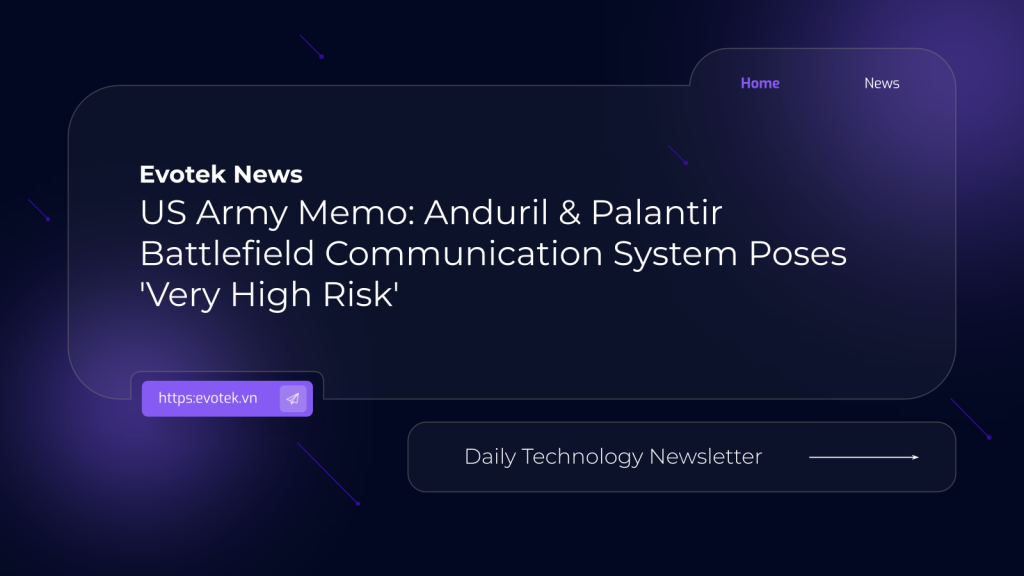A recent internal U.S. Army memo has branded the next-generation battlefield communication system, developed by Silicon Valley innovators Anduril and Palantir, as “very high risk” due to significant “fundamental security” issues and vulnerabilities. This assessment casts a shadow over the modernization efforts critical for the Army’s network, despite the companies’ promises of faster, more sophisticated, and less expensive defense technology.
Army Memo Exposes Critical Flaws in NGC2 Platform
The memo, dated September 5 and authored by Gabriele Chiulli, the Army’s chief technology officer authorizing official for the NGC2 prototype, paints a stark picture of the initial product’s security posture. The NGC2 platform, designed to link soldiers, sensors, vehicles, and commanders with real-time data, was lauded by Anduril for having a prototype operational just eight weeks after contract award.
However, the Army’s report suggests that the rapid development ethos, often seen in Silicon Valley, may not be suitable for vital military infrastructure. Specific concerns highlighted include:
- Lack of control over who can access information.
- Inability to monitor user activities within the system.
- Difficulty in verifying the software’s inherent security.
- A critical flaw allowing any authorized user to access all applications and data, regardless of their security clearance or operational necessity, potentially exposing sensitive classified information without an audit trail.
- Hosting of third-party applications without proper Army security assessments, with one application showing 25 high-severity code vulnerabilities and three others containing over 200 vulnerabilities each.
“Given the current security posture of the platform and the hosted 3rd party applications, the likelihood of an adversary gaining persistent undetectable access to the platform requires the system be treated as very high risk,” the memo states.
Companies Respond: “Outdated Snapshot”
In response to the memo’s findings, Anduril asserted that the reported concerns have already been addressed as part of the normal development process. “The recent report reflects an outdated snapshot, not the current state of the program,” the company stated, emphasizing ongoing improvements.
A Palantir spokesperson similarly affirmed, “No vulnerabilities were found in the Palantir platform.” Despite these assurances, Palantir’s stock (PLTR.O) closed down 7.5% following the report. Anduril, a private company, has plans for a public offering, according to its founder Palmer Luckey.
Balancing Innovation with National Security
The Army’s chief information officer, Leonel Garciga, who supervises Chiulli, provided a more nuanced perspective in an interview. While acknowledging the importance of open communication with vendors, Garciga mentioned that many issues were resolved within weeks or days, with possibly only one application still undergoing vulnerability fixes.
This assessment comes months after Anduril secured a $100 million contract to develop the NGC2 prototype, partnering with Palantir, Microsoft, and other contractors. Garciga also indicated that the Palantir Federal Cloud Service, integral to the battlefield system, could soon receive a “continuous authority to operate” milestone, enabling quicker software updates and deployment.
The Promise of New Defense Technology
Anduril and Palantir are at the forefront of a new wave of defense firms revolutionizing the U.S. military with cutting-edge technologies, including drones, artificial intelligence, and autonomous systems. Both companies have seen their valuations surge, reflecting Washington’s growing reliance on Silicon Valley innovation to counter evolving global threats.
Beyond NGC2, Anduril recently secured a $159 million deal for a night vision and mixed-reality system under the Soldier Borne Mission Command program. Palantir also holds a significant $480 million contract for Maven, an AI tool designed to analyze images and sensor data for battlefield intelligence. This latest security assessment highlights the critical challenge of integrating rapid technological advancements with the stringent security demands of military operations.

 日本語
日本語 한국어
한국어 Tiếng Việt
Tiếng Việt 简体中文
简体中文